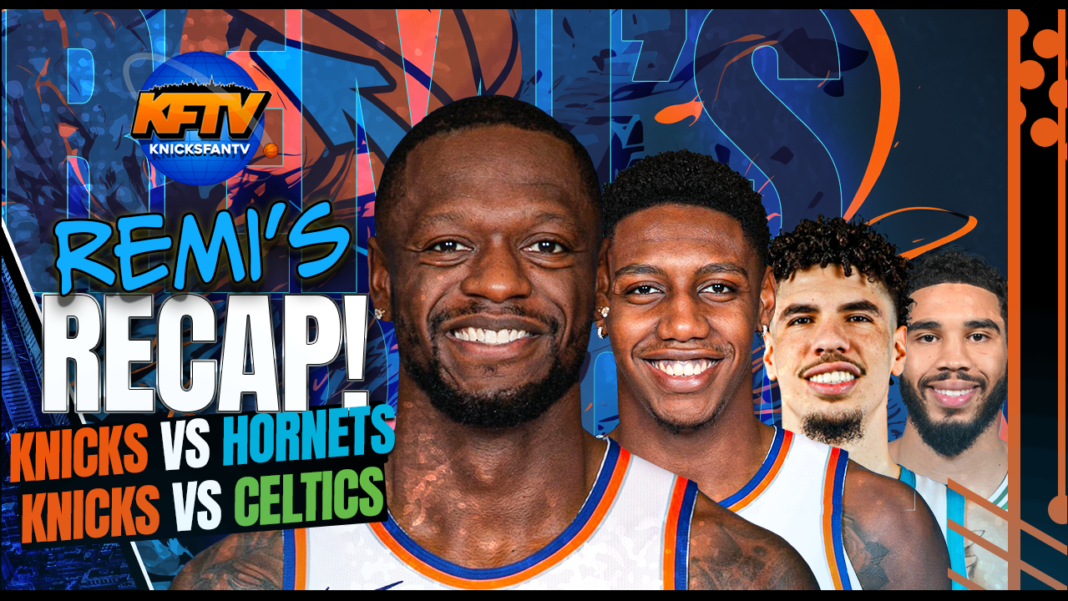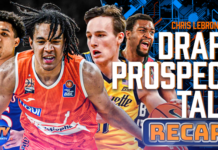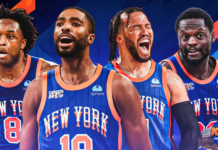The New York Knicks split another back-to-back. They easily handle the Charlotte Hornets, then lose a tough one against the Boston Celtics.
Make sure to catch the whole Knicks Fan TV Postgame show on all major podcast platforms below:
• Spotify
• Apple Podcasts
• Google Podcasts
• Stitcher
The New York Knicks continued their trend, splitting a back-to-back that started against the Charlotte Hornets and ended against the Boston Celtics. New York defeated the Hornets 129 to 108 before losing to Boston 98 to 114.
The Knicks’ offense never looked better than against Charlotte. Their big three dropped 20 points each, and crisp ball movement made everything look easy. The second unit put together a quality game that helped the Knicks starters rest throughout the fourth quarter.
New York took their momentum from Charlotte into Boston for the first half. The Knicks outplayed Boston for two quarters in a battle of the defenses. But with RJ Barrett out, the orange and blue started showing signs of fatigue as the half closed, letting an 8-point lead slip to just 1 in the final minute and a half of the 2nd quarter. Boston maintained intensity while New York’s execution slipped, and they were outscored by 9 points in the third quarter and 8 points in the fourth.
The split reflects New York’s middling record after ten games. But with three back-to-backs, a tough schedule, and three aching stars, the Knicks have plenty of reason for cautious optimism. Let’s look at the players’ performances in the combined double-header.
New York’s big three look great but can’t stay afloat as a big two
Jalen Brunson:
Vs Charlotte – 20 PTS (7/12 FG, 2/4 3PT, 4/4 FT), 1 AST, 1 REB, 1 STL, 1 TO in 27 mins
Vs Boston – 26 PTS (10/21 FG, 3/7 3PT, 3/5 FT), 4 AST, 3 REB, 1 STL, 2 TO in 39 mins
Jalen Brunson is getting back into his groove. He scored at will against Charlotte, producing 20 points in under 30 minutes. His low totals elsewhere result from short minutes and hot hands running the offense for long spells of the action. Brunson’s off-ball success is encouraging because it allowed RJ Barrett and Julius Randle to stay aggressive while they were rolling. He’s not only New York’s best scorer but potentially its most flexible, able to beat teams on the ball or off.
Brunson’s hot shooting carried over to Boston. He shot the three-ball well and knocked down encouraging midrange jumpers. But the Celtics spent most of the time forcing the ball out of Brunson’s hands. Without RJ Barrett, the offense lacked playmaking to capitalize on an unbalanced defense. Brunson still produced a strong game but couldn’t carry the offense through limited spacing, as his teammates always seemed to miss in crucial moments.
New York’s leader looks like he’s back. We still await his touch around the rim to hit peak form. But the Knicks’ leader is hitting jumpers from everywhere, midrange to deep. I wouldn’t stress the low-assist tallies in these two games either, as he didn’t need the ball in the first game and made plenty of quality passes in the second. Brunson gets a 4 out of 5 for the pair of quality performances.
Quentin Grimes:
Vs. Charlotte – 6 PTS (2/5 FG, 2/5 3PT), 1 AST, 1 REB, 1 STL in 23 mins
Vs. Boston – 12 PTS (4/6 FG, 4/6 3PT), 1 AST in 28 mins
Quentin Grimes is still playing too passive. New York’s ball movement against Charlotte seemed perfect for Grimes to find a rhythm. But he passed on too many opportunities and wound up with a modest 2/5 shooting.
He continued to pass too much through the first half with Boston. But Grimes finally let it rip in the third quarter, knocking down 3 three-pointers that kept the game close. He masked what was otherwise a challenging quarter for New York’s offense. Unfortunately, Grimes sat for most of the fourth quarter and returned to a double-digit deficit late.
These are a pair of disappointing performances that end with a sign of optimism. Grimes found some aggression in Boston, and we’ll have to hope he maintains his quick trigger as we advance. His defensive effort keeps him on the floor, but his shooting earns him extra minutes. The Knicks’ most recent first-rounder gets a 2 out of 5, but the path to a more significant impact is clear.
RJ Barrett:
Vs. Charlotte – 24 PTS (9/16 FG, 4/6 3PT, 2/3 FT), 2 AST, 4 REB, 1 STL, 1 BLK, 1 TO in 31 mins
Vs. Boston – DNP
RJ Barrett’s offense looked easy against Charlotte. He shot lights out, beat Charlotte at the rim with a series of patient moves and offhand finishes, and passed the ball better than his 2-assist total suggests. Even Barrett’s 4 rebounds included a couple of tough grabs. He continued his hot start by looking like the best Knick without taking away from Brunson or Randle’s success.
Barrett sat out of Boston with a migraine, though I caught him limping and walking gingerly against Charlotte. So, put me on the skeptical side of things. I’m worried about his knee.
Barrett gets a 4.5 out of 5 for dominating Charlotte enough to sit early. We saw how much New York missed him against Boston. His knee makes me nervous after missing 3 of the first ten games.
Julius Randle:
Vs. Charlotte – 23 PTS (8/16 FG, 1/4 3PT, 6/8 FT), 5 AST, 5 REB, 3 STL, 3 TO in 27 mins
Vs. Boston – 25 PTS (7/19 FG, 2/8 3PT, 8/11 FT), 5 AST, 9 REB, 3 TO in 38 mins
Julius Randle played his best game of the season against Charlotte. He shot a season-high 50 percent from the field by dominating with post moves. Then Randle used his increased gravity to kick the ball out and spark some of the best passing sequences of the game. Even his defense seemed more locked in than ever, with 3 steals and some hustle plays on that end.
Randle kept it up with a nice start in Boston. He had more trouble against Boston’s size inside but made up for it by drawing whistles and free throws. Unfortunately, Boston forced Randle to shoot more, and his jumper continued to lag behind the rest of his game. The All-NBA big played far from perfect basketball, but it was still a promising performance considering the level of defense he faced. I’m particularly pleased he bullied smaller Celtics’ defenders with physicality inside.
We’re seeing Randle find his old form. His decision-making and shot selection feel better than in prior seasons, but 26 percent shooting from three is masking any progress. The improvements will become clear if he can bring that average up even to last season’s 34 percent. Randle gets a 3 out of 5 for the pair of solid outings.
Mitchell Robinson:
Vs. Charlotte – 10 PTS (5/7 FG, 0/2 FT), 9 REB, 1 STL in 24 mins
Vs. Boston – 4 PTS (2/2 FG, 0/2 FT), 1 AST, 6 REB, 1 STL, 2 BLK, 1 TO in 32 mins
Mitchell Robinson’s dominance continued in Charlotte, where he overwhelmed a rising prospect in Mark Williams. With any fourth-quarter minutes, Mitch would have had a double-double. A fun wrinkle in this game was that New York let Robinson work in the post, as he used baseline seals for good positioning that teammates rewarded.
Boston brought the unique challenge of guarding KP, and Mitch looked up to the task early. He spent the entire first quarter setting a defensive tone but couldn’t keep that intensity up throughout the night. Robinson slowed down in the face of an impossible task of protecting the rim while also chasing Porzingis on the perimeter. Even his rebounding numbers suffered.
It looks like the Blockness Monster is too much for traditional bigs. The only way to keep him off the boards is to deploy a stretch five that can drag him away from the rim. Unfortunately, the league has enough shooting big men to create issues. So the Knicks must find effective defensive scheme while Mitch can continue to protect the paint all night. Robinson gets a 3 out of 5 for one strong performance, followed by a decent one.
The Knicks’ second unit goes off in Charlotte, vanishes in Boston
Immanuel Quickley:
Vs. Charlotte – 17 PTS (5/9 FG, 4/6 3PT, 3/3 FT), 9 AST, 5 REB, 1 TO in 26 mins
Vs. Boston – 7 PTS (1/10 FG, 1/2 3PT, 4/4 FT), 1 AST, 6 REB, 1 STL in 26 mins
We saw the best version of Immanuel Quickley against Charlotte. He hit a buzzer-beating three to end the first quarter and continued to knock down shots all night. IQ was elusive off the dribble, which led to a number of beautiful dimes as he drew defenders and fed teammates. It looked like New York’s sixth man of the year was back.
But he looked more like playoff IQ in Boston. Quickley struggled to get any shots to fall, and his inability to score affected his playmaking. Boston’s full-court press made it tough for the second unit to get into sets fast enough to break down the defense in half-court situations. Quickley didn’t show the tools to alleviate that pressure and struggled in a more rushed situation.
If New York is hesitant to pay Quickley, his struggles in the postseason show why. Boston brought playoff intensity, and he struggled again. That was his chance to step up and show that he’s more of a sixth starter than a sixth man, but he failed to answer the call with RJ Barrett out. IQ gets a 2.5 for one excellent performance, followed by a complete dud.
Donte DiVincenzo:
Vs. Charlotte – 9 PTS (3/8 FG, 1/6 3PT, 2/3 FT), 2 AST, 1 REB, 1 BLK, 1 TO in 23 mins
Vs. Boston – 5 PTS (2/6 FG, 1/4 3PT), 1 AST, 1 REB in 16 mins
Donte DiVincenzo thrives when the ball movement is crisp. He couldn’t get much from three against Charlotte, but his constant cutting and attacking led to a solid scoring night with some fun passing. DiVincenzo and Hart’s off-ball movement seemed contagious as teammates followed their lead.
But Boston was less kind to Donte. Their size made him a non-factor going to the basket, and his three-ball continued its feast-or-famine ways. To make matters worse, DiVincenzo didn’t have much impact away from the ball either.
DiVincenzo’s hard work and tough defense has been fun to watch. But his game only feels complete when he knocks down his threes. Unfortunately, he’s been below 34 percent in 7 of 10 performances. We haven’t seen the best of Donte DiVincenzo until his shooting finds consistency. Donte gets a 2 out of 5 for his pair of performances.
Josh Hart:
Vs. Charlotte – 6 PTS (3/6 FG, 0/2 3PT), 2 AST, 4 REB in 27 mins
Vs. Boston – 16 PTS (6/12 FG, 3/6 3PT, 1/2 FT), 3 AST, 9 REB, 1 STL, 2 TO in 43 mins
Josh Hart played well despite his modest stat line against Charlotte. He was a catalyst for ball movement, whether from making the extra pass or timing a clever cut toward the basket. New York had enough hot hands for Hart to thrive without having to do too much.
But New York required way too much from Hart without Barrett in Boston. He guarded Jayson Tatum for most of the action while Boston packed the paint and forced everyone to rely on Hart for offense. To his credit, Hart shot a good percentage and played productive basketball. But he couldn’t produce enough to keep up with his many touches in space or Boston’s onslaught of offense.
Josh Hart is a great glue piece. He hustles and plays the role of connector for a good offense. But he can’t be relied on for floor spacing, and he’s a complimentary playmaker but not a main cog. His numbers look great against Boston, but he slowed down in the second half and didn’t capitalize on enough opportunities. Hart gets a 2.5 out of 5 for a solid pair of performances.
Isaiah Hartenstein:
Vs. Charlotte – 6 PTS (2/3 FG, 2/4 FT), 1 AST, 6 REB, 1 STL, 2 BLK, 2 TO in 18 mins
Vs. Boston – 3 PTS (1/3 FG, 1/1 3PT), 1 AST, 4 REB, 1 STL in 15 mins
Isaiah Hartenstein had a tough pair of games. He played well against Charlotte but continually lost to battle for position under the rim. That led him to a number of loose ball fouls, and he eventually fouled out. But I-Hart was otherwise a beast inside during his limited minutes.
He looked less effective against Boston. Hartenstein’s only basket was a prayer of a three with the shot clock winding down. He did well on the boards but couldn’t impact the middle as effectively with Boston’s combination of size and perimeter play.
Hartenstein did fine for a backup big. But we brag about having the best big-man tandem in the league, and that wasn’t the level of play I-Hart provided. He was a decent backup, but that’s all. We know he’s better than that. Hartenstein gets a 1.5 out of 5 for a limited performance.
The strange rotations of Tom Thibodeau
I keep lingering on the Stefan Bondy article about Knicks’ players with lingering soreness and injuries. That’s because of Tom Thibodeau’s reputation for wearing players down with big minutes loads. It was on my mind when Mitchell Robinson seemed gassed after playing a full quarter and again when the starters lingered on the floor of a game that had long been out of reach.
Closing Thoughts
The Knicks have a built-in excuse for splitting these back-to-backs, but it’s still frustrating. New York’s schedule is rough, and they won’t have rest advantages very often this season. So, this team has to learn how to play through tired legs. Tom Thibodeau’s demanding schemes and short rotations aren’t going anywhere.
But to survive this early stretch at 5-5 is a feat. New York faced quality opponents in all but 2 games during this stretch and blew out both of the lesser teams scheduled. They’ll be fine if they take care of business against weak opponents and continue to challenge the quality opposition. The question is whether or not they can be better than simply fine.
Atlanta is next, and they’ll want revenge for a loss early in the season. Let’s see if the Knicks get back on track and, hopefully, RJ Barrett’s back. I’ll see you then, Knicks fam!
Let us know your thoughts in the comment section below! Also, stay tuned to KnicksFanTV.com for the latest Knicks news, rumors, and recaps throughout the NBA season. And in case you missed it, check out CP on WFAN talking Knicks with the legendary, Bill Daughtry!











